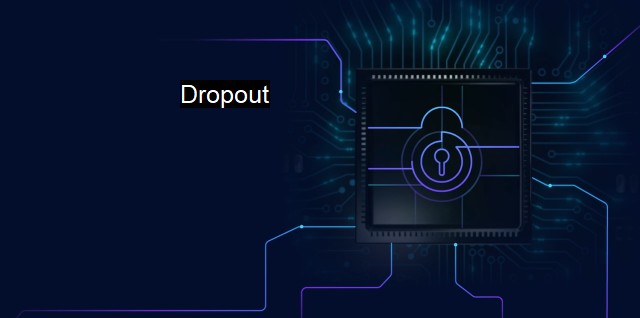What is Dropout?
The Phantom Menace of Dropouts: Navigating Cybersecurity Risks in Network Failures
"Dropout" is a term widely used in various fields such as computer programming, mathematics, and statistics. However the term dropout carries a different dimension of understanding and operation.Cybersecurity is fundamentally about protecting systems, networks, and programs from digital attacks. These cyber attacks aim to gain illegitimate access, destroy sensitive data, or disrupt normal business processes. Today, a vital part of cybersecurity is the proper and comprehensive use of antivirus software, which identifies and removes malicious programs credited with performing such cyber attacks.
Interestingly, the concept of "dropout" in the context of cybersecurity and antivirus does not always directly entail security threats, breaches, or attacks. Cybersecurity dropout may refer to the unintended discontinuities or ordering in the running of antivirus software or the systematic safety of the cyber applications or programs due to various iterative ride effects generated out of, for instance, incompatible system a requirement or a sudden change in the system resource that antivirus demands.
Alternatively, a dropout in an antivirus operation can at times be equated to times when a multi-layered protective software system fails to identify a piece of intricate malware or threats that skiddishly goes unnoticed. That's the nightmare scenario: immutable security weaknesses are created when system defenses fail to recognize and respond immediately. In some cases, powerful malware, advanced persistent threats, and ransomware intricately designed to evade traditional antivirus software are able to infiltrate network defenses or achieve a quiet drop in otherwise rigorous processes, causing a backyard door for future attacks.
This malware avoids being detected by constantly reshaping and relaunching itself in different formats, thus going undetected by even the most stringent antivirus systems. These threats cause significant stress on the system resources, impacting computing power, slowing down overall processes, and attracting further undetectable threats. A possibility of disruption of the normal running of or discrepancies can stem the antivirus program. This leads to a "dropout" of the cyber system's live-running ability.
Dropouts can also take place in terms of human resources and skills where there is a deficient or incomplete understanding of cybersecurity knowledge or measures among professionals that render the system exposed to threats. Due to the rapid and frequent technological progressions, some IT workers may fail to keep up with advancements in cybersecurity and antivirus systems. Untrained workers are more likely to make cybersecurity mistakes like opening phishing emails, having weak passwords, not updating software regularly, or installing suspicious attachments that easily pave the way for potentially encountering harmful malware, leading to severe problems including data loss, multiple system failures, and extended dropouts.
Dropouts can also be following hiatuses borne out of even the most secured antivirus software systems where the much-eyed-for updates from the software manufacturer take significantly longer than required or are pressed with number-skipping errors or rigorously challenging stipulations that engage the client for long-termed checks instead of focusing on killer issues like threat detection.
The term dropout in the sphere of cybersecurity and antivirus denotes a pause, discontinuation, or a brief failing in antivirus operational frameworks which enables the seedlings of cyber threats to grow and flourish, paving way to several unwarranted consequences. Consequently, organizations need continuous foresight into early signs of such vulnerability that bind systems to timely updates, avatar synchronizations, and relentless pursuit of ever-evolving protective methodologies.

Dropout FAQs
What does the term 'dropout' mean in the context of cybersecurity?
In cybersecurity, 'dropout' refers to a situation where a secure network becomes vulnerable due to an interruption in the connection to a security system, such as an antivirus or firewall program.What are the risks associated with dropout in cybersecurity?
If a dropout occurs in a cybersecurity system, it could allow malicious software or hackers to gain access to the network and steal sensitive information, cause financial loss to the company, or damage the network's infrastructure.How can I prevent dropout in my cybersecurity system?
To prevent dropout in your cybersecurity system, consistently monitor your network for any vulnerabilities, conduct routine maintenance and updates, and ensure that your security software is up-to-date and working properly. Additionally, implementing a disaster recovery plan can help minimize the impact of dropout if it occurs.What should I do if I suspect a dropout in my cybersecurity system?
If you suspect a dropout has occurred in your cybersecurity system, immediately isolate the affected device or network segment to prevent further damage. Afterward, investigate the cause of the dropout and take appropriate measures to address the issue, such as installing new security software, updating existing software, or seeking professional assistance.| | A | | | B | | | C | | | D | | | E | | | F | | | G | | | H | | | I | | | J | | | K | | | L | | | M | |
| | N | | | O | | | P | | | Q | | | R | | | S | | | T | | | U | | | V | | | W | | | X | | | Y | | | Z | |
| | 1 | | | 2 | | | 3 | | | 4 | | | 7 | | | 8 | | |||||||